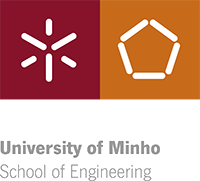Note: Full papers have 20 minutes for presentation, plus 5 minutes for Q&A.
Short papers have 10 minutes for presentation, plus 5 minutes for Q&A.
| 09h30 | Registration |
| 10h00 | Opening Session |
| 10h10 | Coffee Break |
| Session I (chair: Xavier Gómez Guinovart) |
| 10h30 | ASAPP 2.0: Advancing the State-of-the-Art of Semantic Textual Similarity for Portuguese |
| 10h55 | Abcl - Abc music notation with rich chord support |
| 11h10 | Context-Oriented Algorithmic Design |
| 11h35 | NLPPort: A Pipeline for Portuguese NLP |
| 12h00 | Lunch* |
| Sponsor Keynotes (chair: Alberto Simões) |
| 14h30 |
Norma-Simplex: Exploring the Full Spectrum of Languages |
| 15h00 |
Static Application Security Testing |
| 15h30 | Coffee Break |
| Session II (chair: Maria João Varanda) |
| 16h00 | Comparison of segmentable units as indicators of two small corpora being parallel |
| 16h15 | Construction of a Pushdown Automaton Accepting a Postfix Notation of a Tree Language Given by a Regular Tree Expression |
| 16h40 | Raccode: An Eclipse Plugin for Assessment of Programming Exercises |
| 16h55 | Extending the Galician wordnet using a multilingual Bible through lexical alignment and semantic annotation |
| 17h20 | Moozz: Assessment of Quizzes in Mooshak 2.0 |
Note: Full papers have 20 minutes for presentation, plus 5 minutes for Q&A.
Short papers have 10 minutes for presentation, plus 5 minutes for Q&A.
| Session III (Chair: Luísa Coheur) |
| 09h00 | Less is More in Incident Categorization |
| 09h15 | Evaluation of Distributional Models with the Outlier Detection Task |
| 09h40 | eOS: The Exercise Operating System |
| 10h05 | Asura: A Game-based Assessment Environment for Mooshak |
| 10h20 | Non-LR(1) Precedence Cascade Grammars |
| 10h35 | Coffee Break |
| Keynote I (chair: António Leitão) |
| 11h00 |
What Programming Language Design Taught Me About Life |
| 12h00 | Lunch* |
| Keynote II (chair: José Paulo Leal) |
| 14h30 |
From Eliza to Siri A brief survey on Natural Language Understanding |
| 15h30 | Coffee Break |
| Session IV (Chair: Nuno Carvalho) |
| 16h00 | CaVa DSL: virtual Learning Spaces Formal Specification |
| 16h15 | Path patterns visualization in semantic graphs |
| 16h35 | Kaang - a RESTful API Generator for the Modern Web |
| 16h50 | Predicting performance problems through emotional analysis |
| 17h05 | LearnJS - a JavaScript Learning Playground |
| 17h30 | Ending Session |
What Programming Language Design
Taught Me About Life
(Kent Pitman — HyperMeta, Inc., USA)
Through my many years of involvement in the design, standardization, and
use of various Lisp dialects, including Common Lisp, ISLISP and Scheme, I
came to see languages as much more complex entities than mere functional
behavior or stylized syntax. Languages are about community and shared
values—and not just the kinds of values that get returned from a function
call. The choices a language designer makes will attract certain users and
alienate others. That’s a responsibility to be taken very seriously. I’ll
highlight some of the complex choices that differentiate various
programming languages, and survey some of the factors that can influence
such choices, as well as the consequences that can come of them. Along
the way, I’ll also share some of the life lessons I took away into the
real world from my own experiences in language design.
From Eliza to Siri
A brief survey on Natural Language Understanding
(Luísa Coheur — Instituto Superior Técnico / INESC-ID, Portugal)
Natural Language Understanding is
usually defined as the task of mapping natural language into some
meaning representation that the computer is able to
understand. Natural Language Understanding models are at the core of
several applications in the area of Human Language Technologies,
ranging from simple tasks in which short commands are uttered to
robots, to complex dialogue systems or reading comprehension
exercises. However, natural language is much more difficult to conquer
than we tend to believe, and, therefore, Natural Language
Understanding research is still far from being able to offer general,
mature and fully automatic solutions. In this talk, I will review the
main ideas behind old and current Natural Language Understanding
models. I will describe the main achievements, but also the challenges
that still need to be surpassed in what I consider to be the holy
grail of Human Language Technologies.
Norma-Simplex:
Exploring the Full Spectrum of Languages
(Nuno Carvalho — United Nations University (UNU-EGOV), Portugal)
Languages come in many flavours and with different purposes. This talk
illustrates the heterogeneous use of languages in different settings
in the context of the Norma-Simplex project, an infrastructure for
legal documents analysis, assessment, and re-factoring. From the
programming languages used to perform different tasks, to the markup
languages used to store models and interchange information between
systems, including the natural languages techniques being explored in
between.
Static Application Security Testing
(José Pereira — Checkmarx, Portugal)
Have you considered auditing your source code using static analysis tools? What do these things pick up that you can't with a code review? How do they work?
Software security concerns have fortunately been increasing over the last few years, certainly due to the continuous growing number of threats being thrown at our applications every day. Still, not every project's contributor is a software security expert and hiring one to perform thorough code reviews for each contribution can be unsustainable.
This is where SAST (Static Application Security Testing) comes in. These tools rely on static source code analysis to parse and query abstract syntax trees, or parse trees, inferring potential vulnerabilities without having a running system. The basic components of these tools will be discussed as well as their pros and cons.




















